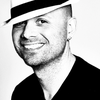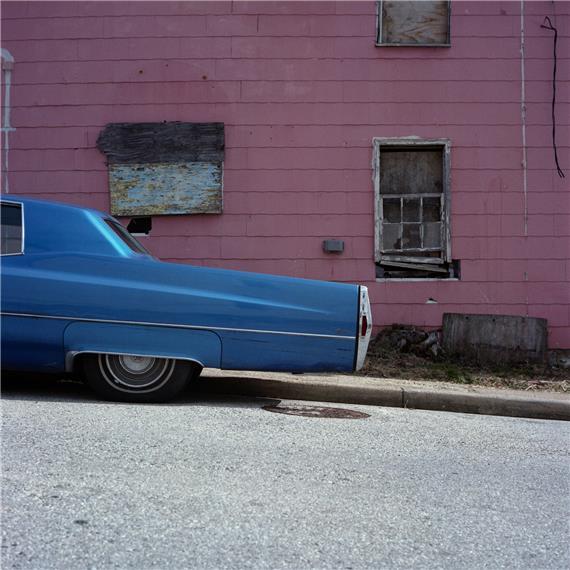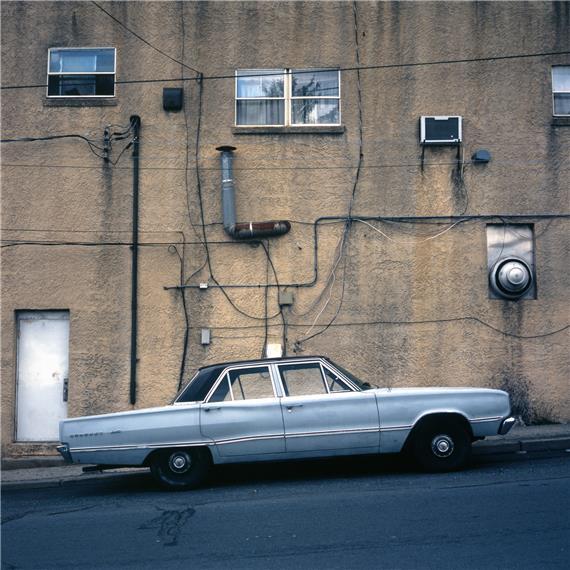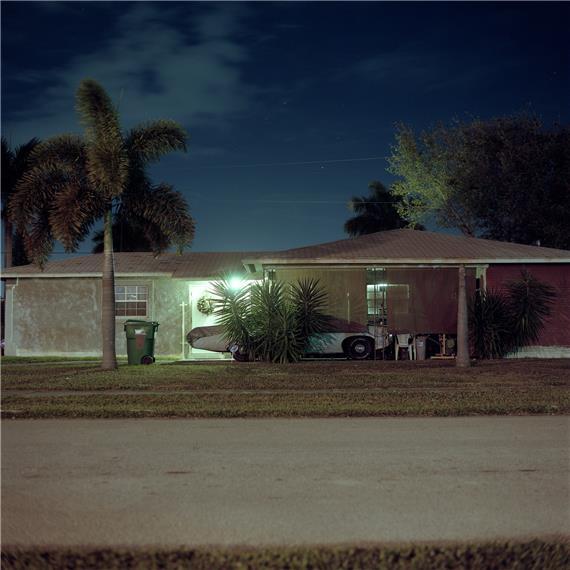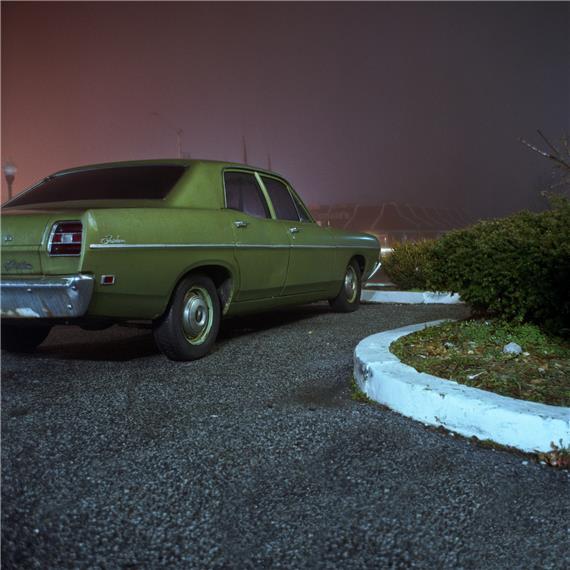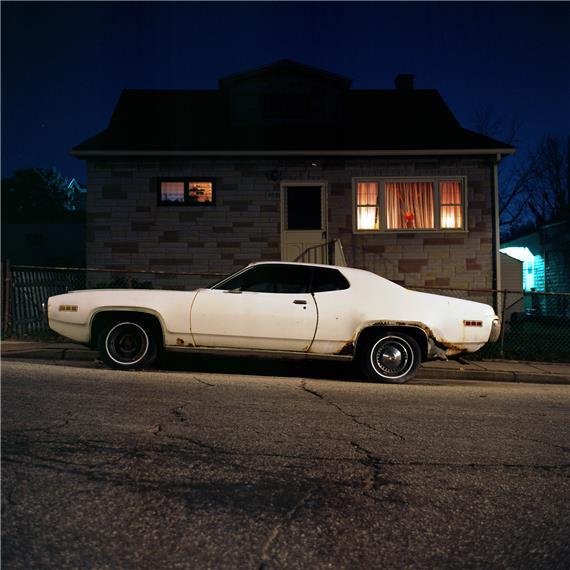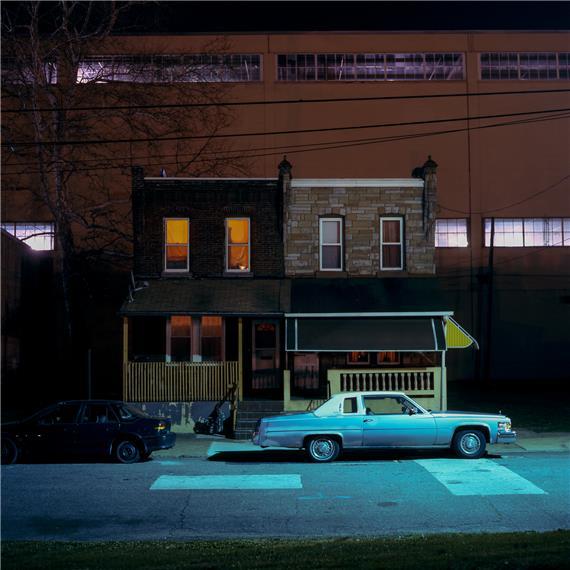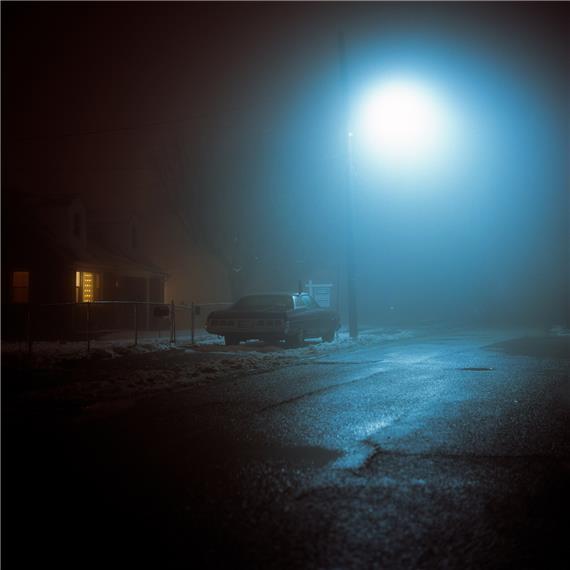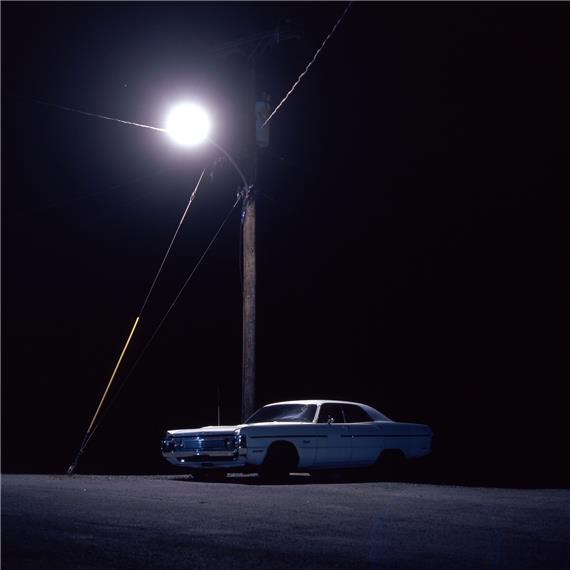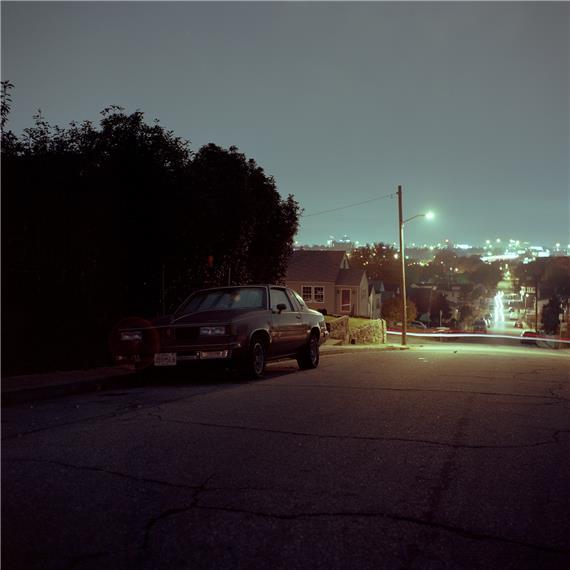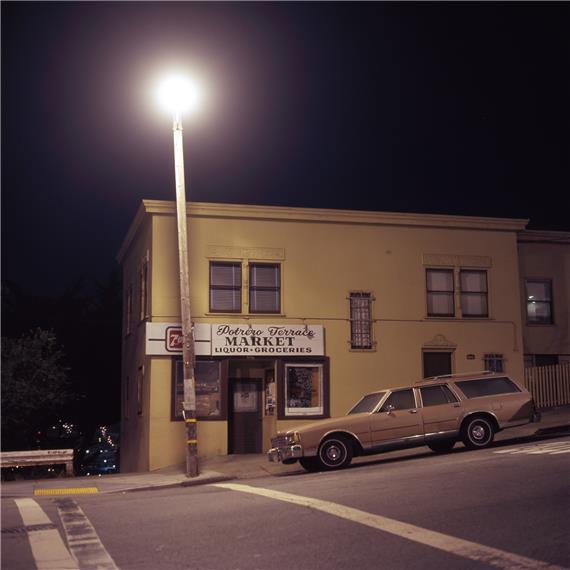My father liked any kind of car, it only had to be, well, old. He loved old cars. How I wish he was still with us to see Patrick Joust's photography. He would have loved these photographs. Patrick's photographs are both vivid and dreamy. With the help of medium format negatives, he transports his viewer to the actual scene - it's as if we are there, right on the street corner with these cars. Simply put, I like this work and my father would have loved it. For both of these reasons I am very pleased to bring to you the photographs (and the words) of Patrick Joust.
Michael Ernest Sweet: Patrick, I love this work. I'm a fan of cars, film, and night scenes. You've combined all three and you have done it exceptionally well. Why cars?
Patrick Joust: That's a good question. I'm not really a car buff, though I can certainly appreciate the beauty of the car, like the lines of a Karmann Ghia or a Citroën DS. Sometimes people will ask me though about makes/models and I usually know very little. I know just enough about cars to make myself almost believe I can avoid getting ripped off by a mechanic. One of the things that attracts me to cars in my photography is simply their "oldness," particularly American Cars of the late 60's through the early 80s. I never go to car shows or anything like that because I'm interested in things that have aged and reflect aspects of the past in the present, especially when they can be found in compelling surroundings.
Like a lot of people, I have a love/hate relationship with cars. Some of my most cherished experiences have been on road trips. The "loneliest road" in Nevada, the Pacific Coast highway, rural roads in Nova Scotia, etc., but I also hate what the car has done to our society. How the car, as a mindless entity, rules over everything, wasting the countryside and cities alike. Like our response to a lot of technological innovation, much of humanity has molded itself to fit the needs of the machine, constantly streamlining and simplifying; rolling over whatever doesn't fit. I like taking pictures of tired worn out cars, in part, because they represent, for me, a tired worn out idea. They anchor us to an infrastructure that can no longer be sustained. I particularly like to capture scenes of the car and the environment around it, where you can see its impact on the social landscape.
I don't mean to be such a downer though. The contradictions evoked by the car: liberation, alienation, freedom, confinement, creation, destruction, all make them interesting. I also think, like a lot of photographers, that I'm drawn to old cars found on the street because they are unique. Anything you don't see as much of anymore is worth photographing.
MES: Where and how did you find all these old cars?
PJ: Just walking/driving around, sometimes using google street view... that sort of thing. There are certain neighborhoods in Baltimore where I know I'll find old rusty cars. The biggest challenge is not so much finding the cars but finding them in an interesting context. When shooting at night, the lighting situation becomes all the more important. Too much or too little light or a street light in the wrong place can make it difficult to pull off a good capture.
MES: Every photograph almost seems to truly be from another era. It almost seems as though these scenes are staged. Are they?
PJ: Thanks! No, they're definitely not staged. A lot of the fun is finding these scenes as is. While the final product is perhaps the most important thing, the process is highly enjoyable to me. Photography does that for me in a lot of ways. It gives me an excuse to explore people and places that I might not otherwise. It makes abstractions tangible, creating a relationship between me and a particular place, person or object.
MES: Okay, now let me ask why film? I don't want to get into the whole film versus digital thing. I think that's been settled. Both are here to stay. But, I think it is still a valid question to ask why one chooses one over the other for a particular project.
PJ: All of the images in this set, and most of my night photography, were taken on medium format film. I enjoy a lot of different photography formats, including digital. Occasionally, I use digital at night as well. I borrowed a friend's 5D Mark III and took some hand held portraits at night for a photo essay last spring. It was amazing to shoot with such clarity, in color, at such high ISOs. But film has a quality and variety that I enjoy even more, particularly for long exposures. I like being able to pick an emulsion and see how it will behave under certain lighting conditions and exposures.
A medium format negative or positive can record an amazing amount of information. There isn't an exact correlation here, but in terms of megapixels, I've read that it could be anywhere from 50 to 80, depending on the emulsion and format. So I'm shooting both for the aesthetics of the film itself but also because of the amazing resolution. I like shooting polaroids and 35mm too, just for the look of it, but short of medium format digital (very expensive), or large format film (not as mobile/convenient and also expensive), it's pretty hard to beat 6 centimeters of film.
MES: I hate this question, but readers always want to know. What camera were you using?
PJ: All of the images in this set were taken with a twin lens reflex camera. I own several, but the one I use most at night is the Mamiya C330. It's a big bulky camera, but very precise with a bright screen and interchangeable lenses. I used to use a Yashica Mat and I sometimes use a Rolleiflex too.
MES: I think these images benefit greatly from color. However, I can imagine that color film is also a hassle in these lighting conditions - low light, that yellow street lamp hue everywhere. Yet, you've handled this masterfully. I'm especially surprised by how little of that yellowish hue is showing up in these images. How'd you do this?
PJ: The strong yellow light from sodium vapor lamps can definitely be an issue. Sometimes I kind of like it, but other times, like you say, it can overwhelm everything. Baltimore has been using an increasing number of LED lights, which give off a somewhat dimmer/targeted, cooler light. With some films the light actually turns blue, but you definitely lose the yellow tint you have with sodium vapor.
Of course, since I'm digitizing these images, I also can do a little editing in post. Anything that's bathed in a particular color can't be easily edited out, without looking weird, but you can make some adjustments to improve the balance. The particular emulsion also helps. A lot of these images were taken on tungsten balanced film which makes skies a deep blue. Certain films run cooler than others (Kodak Ektar, for instance), so I change things up a lot for the sake of variety.
MES: I'm a book photography myself, and when I see a body of work like this I automatically think of it as a book. It would be fantastic. I think a lot of car people, as well as photographers, would be eager to get their hands on a copy. Any thoughts or plans for publishing this work?
PJ: Well, I actually do have a book of sorts. It's called The Old Cars, which references Lee Friedlander's The New Cars, 1964. The pictures aren't very Friedlander like, but I'm a big fan of his work. My little soft cover book has about 50 images of cars taken mostly in Baltimore but also other parts of the Americas and Europe. At some point I'd like to do something more substantial, but the format I used allowed me to create a book that looks good but is also not too expensive. I haven't sold many, but what little profits I've collected help with film and processing.
MES: Patrick, can you tell us a little about how you came to be a photographer?
PJ: I came to photography kind of late compared to a lot of my friends. It wasn't until a year or so after college that I thought about it seriously. At the time I was mostly drawn to documentary photography and urban landscapes. It's only been in the last 5 years or so that I started doing the whole long exposure medium format thing. There were several photographers on flickr who were doing amazing night time work that I found inspiring. The work of Mando Alvarez, in particular. He was also a big help in giving me basic advice on how to get started. After a while, I more than doubled the amount of work I was doing. I never lost interest in taking pictures in daylight, but it was great to explore urban and suburban environments after dark as well.
MES: Whose work have you found inspiring? Please mentions some of your contemporaries too, if possible, not just the dead guys.
PJ: Actually its my contemporaries that have probably had the most influence on me. Of course I already mentioned Mando Alvarez. A few years ago I started a flickr group called Auto-Anthropology that was largely inspired by the work of David Glass. He has a collection of images called The Automobile as Landscape. I hope, someday, that those images find their way into a nice book. Another photographer, who helps to run the Auto-Anthropology group with me, is Christopher Hall. He has a couple of beautiful photo books on cars that can be found here. I also want to mention Dan Wetmore, another big inspiration. I could mention many more, but all of these photographers kind of set the standard for what great "car photography" is all about.
MES: There is a very cinematic feel to a lot of these images. Do you ever draw inspiration from films? If so, which ones or which directors?
PJ: Thanks! Noir and especially neo-noir movies from the 60's and 70's have definitely have been an influence. The Parallax View, The Conversation, The Gambler, The French Connection, the work of Jean-Pierre Melville, Poliziotteschi (don't ever ask me to pronounce that) movies, all have an aesthetic that draw my attention and, I'm sure, inform what I'm doing at night.
MES: I've always been a little scared of film photography at night because of the exposures. I guess I feel it's all too complicated. I'm sure I am not alone. Any advice for people starting out with analogue night photography?
PJ: It feels so relaxed and normal for me now, but I definitely remember feeling nervous about it at first. Studying Fred Parker's Ultimate Exposure Computer was a big help. After that, just getting out there and practicing. Not being able to get instant feedback is sometimes a challenge, but I've also had the experience of viewing something on the LCD screen of my digital camera that seemed fine at that size but didn't look so great when I actually saw the finished product on a large computer screen. Still, digital can be helpful. Depending on the type of film you might be using, reciprocity failure is an issue, but practicing with digital (in manual mode) can definitely give you a good idea of exposure times, apertures, etc. for various situations.
MES: Patrick, again, this work is simply fantastic. I want to thank you for sharing it with us. Photography is a hard game, and images without the human element are always more difficult. Yet, you've created a whole body of work here that is truly remarkable. Be very proud of it and I hope to find it between two nice big hard covers one day soon.
PJ: Thanks very much for featuring my work and posing these interesting questions. This was a lot of fun.
Patrick Joust is 36 and lives in Baltimore with his wife and son. Born in Oroville, California, Patrick has gone back and forth between both coasts of the United States, before settling permanently in Baltimore in 2006 where he works as a reference librarian. During the day he can often be found engaging Baltimore's people on the streets, while at night he enjoys capturing urban/suburban landscapes and scenes. Follow Patrick through his website by clicking here.
Michael Ernest Sweet is a Canadian writer and photographer. Follow Michael on Twitter @28mmphotos.
